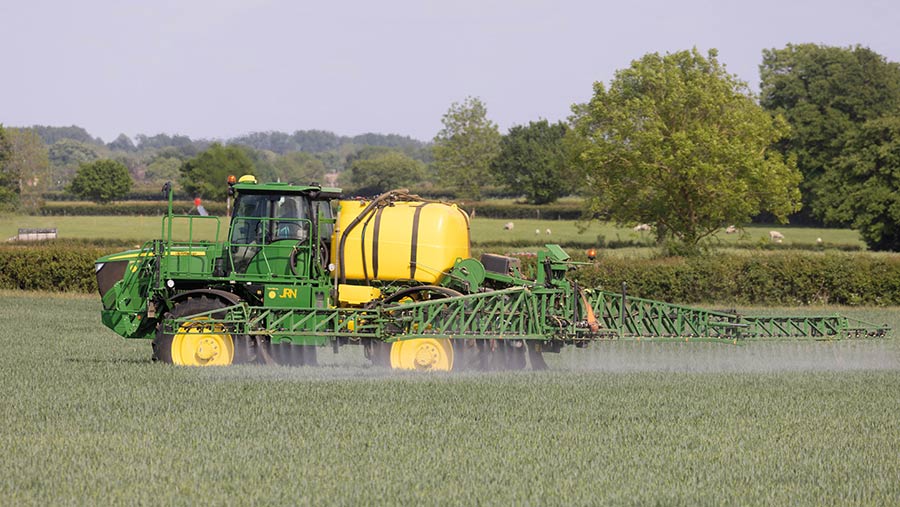Advice on controlling wheat disease as fungicide prices rise
 © Tim Scrivener
© Tim Scrivener Don’t be afraid to use fungicides this year, despite the urge to reduce costs and use fewer inputs in the current economic climate, agronomists agree.
There is rarely a year when growers don’t see at least a 1.5t/ha response from a good fungicide programme, they point out, although the variety effect and any specific site factors should always be considered before final plans are made.
“To give it some focus, a robust four-spray programme is equivalent in cost to about 0.6t when wheat is priced at £220/t,” says Chris Bean, technical director of Zantra.
See also: New winter varieties help to address mustard shortfall
If wheat drops to £150/t, you will need 0.8t to cover your costs, but only 0.4-0.5t if it rises to £240/t.
“With that in mind, if you know that you are only likely to see a 0.5t/ha response from a resistant variety, you should think twice.”
Variety response
When it comes to variety choice and disease resistance ratings, Mr Bean points out that when popular Group 2 Extase first came to the market in 2019, it gave a much lower response to fungicides than it does now.
“Last year, in our trials, we saw a 2.5t/ha response with Extase,” he reveals. “And that came in a low to moderate year for disease.
“That is in sharp contrast to its performance in 2019 and 2020, when it didn’t seem to need much of a fungicide programme. The situation changed in 2021, when septoria really made its presence felt, affecting most varieties.”
Mr Bean highlights Extase because it now accounts for 20% of the wheat area grown, which helps to explain why its resilience to disease has changed.
Appropriate spend
Making the decision to spend wisely on fungicides is very similar to the current dilemma in terms of nitrogen fertiliser, says James Warne of Soil First Farming.
“Just as you can’t cut nitrogen rates too far, you shouldn’t be afraid of using fungicides,” he says.
On a tight budget, a “batting order” can help, he suggests, as there is a bigger yield response seen from the T2 timing than the others.
“Then it’s a close call between the leaf two timing and the ear spray – with the ear spray usually winning.”
However, setting your stall out too early is a mistake – as things can go wrong, he adds. “Be flexible in your approach and adapt where necessary. Quick fixes don’t exist.”
Disease is driven by interactions between the pathogen, the environment and the host plant, advises Mr Warne, which is why grower interventions can change that dynamic.
“Get the basics right. Start with the soil, manage nitrogen, balance it with other nutrients, make best use of decision-making tools and use integrated pest management. Then spend appropriately on fungicides, according to need.”
“The combined area of two more recent Group 4 introductions, Champion and Dawsum, which both have good disease resistance, is also 20% of the wheat area,” he says.
“So, what we’ve seen with Extase, we can expect to see with these types in future years if they remain popular choices.”
In general, the responses from new, more resistant varieties were lower last year and they do offer scope for fungicide reductions, he acknowledges, with Group 2s Palladium and Mayflower both giving 1.2 t/ha, and Dawsum 0.8t/ha.
“It was the older Group 1 varieties that were in trouble – they gave a 4t/ha response to fungicides and needed all the help they could get. It’s no wonder their area is back by 10%.”
Spray priority
The T0 spray is the one that is most often questioned, he says, which is why Zantra’s trials in 2022 looked at fungicide programmes both with and without a T0.
Where a T0 was applied, it was a tebuconazole + prochloraz mix.
“What we found was that in a low disease year, the T0 delivered just over 0.3t/ha response and gave a £70/ha return.”
One reason for the T0 response is likely to be the damp, mild winter of 2021-22, which allowed both rust and septoria infections to overwinter unchecked, along with plenty of stubbles to harbour them.
“We are seeing warmer-than-normal winters,” says Mr Bean.
“It will be interesting to see how much the frosts have helped this year – there certainly isn’t as much yellow rust around as there was at the same stage last year, but it’s easy to find septoria.”
In terms of varieties, Dawsum gave a 0.2t/ha response to a T0, which was 25% of its yield response to the whole fungicide programme, while Extase gave a 0.5t/ha response – possibly due to its eyespot susceptibility.
The Group 3 variety Brium gave a 0.6t/ha response.
Mr Bean recognises that it will be tempting to leave the T0 off with certain varieties, but suggests growers check that they will not be losing more than they are saving.
“You have to question whether that’s the right approach with Extase, for example.”
What do price rises look like?
Fungicide price hikes in the region of 20% mean a two-spray programme, using SDHI chemistry at T1 and T2, will cost about £100/ha in 2023.
Where either a T0 or a T3 is required, or a rust-specific product has to be included, these costs will rise further.
These increases mean the T1 spray could cost £40/ha, with the T2 timing totalling £55-£60/ha – which means growers are looking at a £10,000 spend for 100ha.
While most growers will be keen to keep disease out of their crops and see them finish well, that higher level of expenditure does create a quandary with less-responsive varieties.
The other unknowns are the weather and the supply situation, with dry February conditions already causing some concern, especially in parts of East Anglia and the South West, and predicted shortages of key active ingredients after the teething problems with Inatreq (fenpicoxamid)-containing fungicides.

